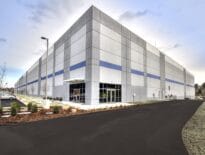
The new law requires MBTA communities to allow multifamily zoning by-right near train stations and points where bus lines intersect. A 2021 Metropolitan Area Planning Council study estimated this would create 31,000 acres worth of development sites in 38 communities that currently have more restrictive zoning.
Suburban leaders are taking aim at a centerpiece of the Baker administration’s plans to tackle the state’s housing crisis by spurring construction of hundreds of thousands of new apartments and condominiums.
The Massachusetts Municipal Association and the Massachusetts Municipal Lawyers Association are raising serious concerns about the MBTA Communities law and in particular how state officials hope to go about enforcing it.
The new law, which passed last year, uses the threat of the loss grant money to prod cities and towns within a certain distance of T commuter rail, bus and subway stops to open the door to hundreds and in some cases thousands of new multifamily units in various communities.
However, some communities, especially smaller ones in the outer suburbs without sewer service or municipal water, may simply take the hit and lose state grant money rather than comply with the law, which would require towns to zone for at least 750 new multifamily units, the two groups warned.
But in their opposition, local officials are going beyond mundane complaints about the lack of infrastructure to raise concerns of a fuzzier, more metaphysical nature, namely that opening the door to large numbers of multifamily units will negatively alter the time-honored “character” of individual towns.
It is a theme that Republican candidate for governor Geoff Diehl seized upon, injecting himself into the debate over Baker’s housing plan.
And as he scrounges for votes in his quixotic campaign for governor, the favored candidate of the MassGOP’s Trump wing is clearly hoping to tap into the ire of suburban NIMBY types.
Diehl, in a statement, said he is all in favor of “more affordable housing alternatives.”
But Diehl goes on to warn the state’s push for more apartments and condos could lead to more “high-density multifamily housing” that would “significantly change the traditional look and feel of these communities against their will.”
To which I say to Diehl, the MMA and all the local officials up in arms over the idea of multifamily housing – where have you been for the last three decades?
The so-called “character,” as in the demographics, as well as the look and feel of towns across Greater Boston, has been warped almost beyond recognition in recent decades. Not by what has been built, but rather by the regressive market forces communities have unwittingly unleashed by barring new housing at every opportunity, often in the name of preserving community character and the status quo.
If that was the goal, they have failed miserably, because the housing shortage such NIMBY policies have created have led to a relentless upscaling and gentrification.
“The state’s plans could lead to more ‘high-density multifamily housing’ that would ‘significantly change the traditional look and feel of these communities against their will.”’ — Republican Candidate for Governor Geoff Diehl
Decades of NIMBYs
Efforts by towns and suburbs to block new housing began to gain critical mass in the 1990s just as the Boston area was achieving economic liftoff thanks to its research universities, hospitals and the growth of the tech and later life sciences industries, not to mention a booming financial services sector.
All those highly paid researchers, workers and executives helped drive up the prices of homes in the Cambridge/Somerville area and in towns along and inside the 128 beltway to levels unimaginable three decades ago.
As we entered 2022, the median price of a home hit $1 million and up in more than 20 different towns across Greater Boston and the Cape and Islands, including Nantucket ($2.2 million), Brookline ($2 million), Weston ($1.8 million), Chilmark ($1.7 million), Cambridge ($1.68 million) and Wellesley ($1.65) million, according to The Warren Group, publisher of Banker & Tradesman.

Scott Van Voorhis
A number of communities that have crossed the $1 million mark in the last few years, like Westwood, Carlisle, Sudbury and Manchester. That’s a five-fold increase from a decade ago, when there was just five.
And more are waiting in the wings, with the median price in Somerville, Jamaica Plain, Orleans, Truro and Chatham all closing in on the million-dollar mark.
Moreover, with no new subdivisions of single-family homes getting built in pretty much any of these communities, pent-up demand has led the rise of the tear down, and where older, more modesty sized home, often a ’50s or ’60s ranch or split level, is taken down to make way for McMansion.
A phenomenon that a few years ago was confined to uber wealth suburbs like Wellesley, Weston and once-solidly middle-class Needham, the tear-down trend has now spread to fast-gentrifying towns like Natick.
Tear downs that destroy the already dwindling stock of middle-class homes certainly speak to a community’s character, and it’s not a particularly flattering reflection.
In fact, a surge in multifamily housing might actually bring back middle- and working-class families to towns and suburbs across the Boston area from which they are being increasingly excluded.
If that doesn’t count as preserving community character, I don’t know what does.






